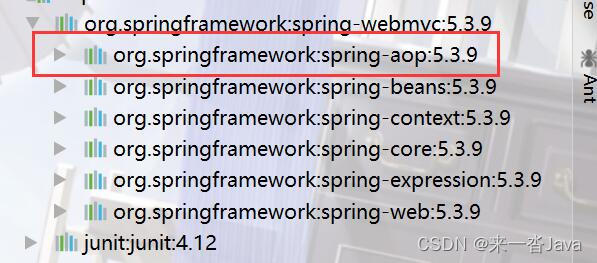一、使用注解开发
- 在Spring4之后,要使用注解开发,必须要保证aop的包已经导入了

- 使用注解需要导入context约束,增加注解的支持
<?xml version = "1.0" encoding = "UTF-8"?>
<beans xmlns = "http://www.springframework.org/schema/beans"
xmlns:xsi = "http://www.w3.org/2001/XMLSchema-instance"
xmlns:context = "http://www.springframework.org/schema/context"
xsi:schemaLocation = "http://www.springframework.org/schema/beans
http://www.springframework.org/schema/beans/spring-beans-3.0.xsd
http://www.springframework.org/schema/context
http://www.springframework.org/schema/context/spring-context-3.0.xsd">
<context:annotation-config/>
</beans>属性如何注入
//等价于:<bean id="user" class="com.rxj.pojo.User">
//@Component 组件,放在类上,说明这个类被Spring管理了,就是bean
@Component
public class User {
//相当于<property name="name" value="来一沓Java"/>
//@Value("xxx") 放在属性上面,可以指定属性的值
@Value( "来一沓Java" )
public String name;
}衍生的注解
@Component衍生的注解,在Web开发中,会按照mvc三层架构分层
- dao层 【@Repository】
- service层 【@Service】
- controller层 【@Controller】
这四个注解功能都是一样的,都代表将某个类注册到Spring中,装配Bean
二、xml与注解相比
- xml更加万能,适用于任何场景!维护简单方便
- 注解不是自己的类使用不了,维护相对复杂
三、xml与注解最佳实践
- xml用来管理bean
- 注解只负责完成属性的注入
- 在使用过程中,只需要让注解生效,就需要开启注解的支持
<!-- 指定要扫描的包,指定的这个包下的注解就会生效--> <context:component-scan base-package="com.rxj"/> <context:annotation-config/>
四、使用java的方式配置Spring
在这里我们完全不使用Spring的xml配置了,全权交给Java来做。
javaConfig早期是Spring的一个子项目,在Spring4之后,它变成了核心功能!
实体类:
//这个注解的意思是说这个类被Spring接管了,注册到了容器中
@Component
public class User {
private String name;
public String getName() {
return name;
}
@Value( "来一沓Java" ) //注入属性的值
public void setName(String name) {
this.name = name;
}
@Override
public String toString() {
return "User{" +
"name='" + name + '\'' +
'}';
}
}配置类一:
@Configuration //这个也会被Spring容器托管,注册到容器中,它本身就是一个@Component
// @Configuration代表这个是一个配置类,就和applicationContext.xml是一样的
@ComponentScan("com.rxj.pojo")//扫描包
@Import( UserConfig2.class )//导入其他的配置类
public class UserConfig {
//注册一个bean,相当于xml中的一个bean
//这个方法的名字,相当于bean标签中id的属性值
//这个方法的返回值,相当于bean标签中class的属性值
@Bean
public User user(){
return new User();//返回要注入到bean的对象
}
}配置类二:
@Configuration
public class UserConfig2 {
}测试类:
public class MyTest {
public static void main(String[] args) {
//如果完全使用配置类去做,就只能通过AnnotationConfigApplicationContext上下文获取容器,通过配置类的class对象加载
ApplicationContext context = new AnnotationConfigApplicationContext( UserConfig.class );
User user = (User) context.getBean( "user" );
System.out.println( user.getName() );
}
}





















 8万+
8万+











 被折叠的 条评论
为什么被折叠?
被折叠的 条评论
为什么被折叠?










